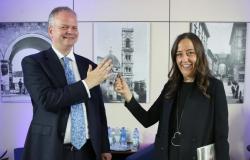Verona is always a good idea for an escape in search of hidden treasures. With an exceptional guide: the art historian and cultural tourism expert Beba Marsano
There’s no denying it: we’re talking about Verona and the thought of immediately comes to mind Romeo and Juliet. The tragedy of the most famous pair of lovers ever ends, in the imagination of William Shakespeare, right here, also the city of Catullus, poet of love and of the Supreme Poet Dante Alighieri. For centuries it was one of the stops on the Grand Tour of greats from Byron to Dickens, from Goethe to Mozart and of admirers curious to see his beauties. Nestled in the Venetian plain between the bends of the Adige, Verona has historical and cultural jewels to spare.
Sometimes isolated and secret, which alone are worth the trip. Word of Beba Marsanoart critic and journalist, author of the eighth edition volumes “Goodnight books” published by Minerva: an exclusive collection, created in collaboration with the Duetorrihotels Group, dedicated to the cities of art – Bologna, Verona, Florence and Genoa – seen through a particular lens. In Verona the author has selected a series of particular places, they enhance what is hidden from the sight of the common tourist. First among all, Palazzo Maffeiin Piazza delle Erbe, a treasure chest of rare beauty, which houses the entrepreneur’s treasure Luigi Carlon, one of the greatest Italian collectors: very precious works, from classicism to modern and contemporary art. About two thousand years of wonder and surprise among medieval tondi, crucifixions and Fabergé rock crystal objects accompany paintings by Magritte, Fontana, De Chirico, Kandinsky. The news? In the last museum room, dedicated to a project room with new proposals, there is the LOTUS Maffei installation by contemporary artist Daan Roosegaarde, which combines interactive light technology, art and the theme of environmental sustainability. These are intelligent flowers, sensitive to light and heat, which move based on contact with people. 5 minutes away, the Basilica of Sant’Anastasiaa splendid example of Italian Gothic, very rich in works of art, it preserves the famous fresco by Pisanello, San Giorgio and the Princessabove the Pellegrini Chapel, considered one of the greatest masterpieces of fifteenth-century painting in Italy. It seems that the master Franco Zeffirelli was seduced by the vision, so much so that he referred to the very refined clothes in this painting for the costumes of his famous “Romeo and Juliet”.
Overlooking the Church of Sant’Ananstasia, a stone’s throw from Juliet’s balcony, Piazza Bra and the Arena, cradle of Italian and international opera music, the 5-star Luxury Due Torri Hotel is the prestigious custodian of the city’s memory. Crossing the threshold you enter un a palace that preserves rare testimonies of art and history, Biedermeier furnishings, marble and fine porcelain. The building dating back to 1300 (an inn since 1674) has hosted the most important figures of every era: in its rooms they slept a Mozart thirteen year old and Goethe, Napoleon III and Garibaldi, Callas, Thatcher and the emir of Dubai, which occupied 60 rooms out of 89. The flagship it is the Arena Casarini, work of the greatest Italian fresco artist of the twentieth century: an equestrian circus that comes to life within the walls of a room, halfway between architecture and figurative art. A few meters away, among vaults and museum pieces, the Due Torri table with a menu with a careful selection of gourmet products. The highlight of the summer is the terrace with incredible views of the old city surrounded by the rolling hills of the Adige, where you can savor exquisite dishes. A second internal restaurant is an elegant bistro, led by chef Salvatore Garofalo.
Unknown to most, the Convent of San Bernardino, 15th century convent complex (which includes the Church characterized by numerous richly frescoed chapels including the Pellegrini chapel designed by the famous Veronese architect Michele Sammicheli), which houses an important treasure. Which? The marvelous Sala Morone frescoed by Domenico Morone with the help of his son Francesco between 1494 and 1503 and turns out to be one of the most important Renaissance works in Verona. Along its walls unfolds a series of illustrious Franciscans, including the popes of the order, painted life-size. It is thanks to the semi-enclosure of the convent that it has remained in a good state of conservation. A real gem in the artistic panorama of the city is the Cavalcaselle Fresco Museum at Juliet’s Tomb. You have to reach the former convent of the Friars Minor, from the 13th century, to see what, according to tradition, is believed to be the sarcophagus that housed Juliet’s body. The Museum, however, preserves frescoes from religious and private buildings, Renaissance works from Torbido, Brusasorci, India and various sculptures.




